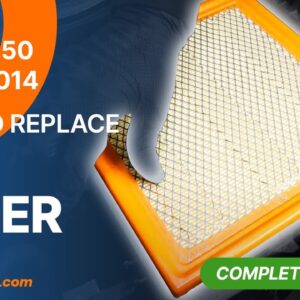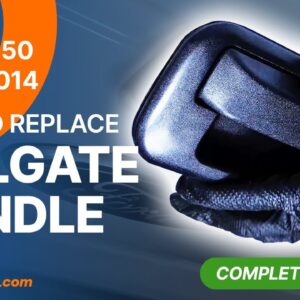Watch this video to learn how to replace the water pump on a 2009-2014 Ford F-150.
Replacing Water Pump on a 2009-2014 Ford F-150: What You Need
Ready to perform this DIY replacement job? Remember that all the parts in this guide can be found on CarParts.com. Check out all the products that fit your vehicle right here.
Parts Checklist
Tightening Torques
- Water pumps bolts: 18 Ft-lbs.
- Water pump pulley bolts: 18 Ft-lbs.
Tools Checklist
Here’s the toolbox we recommend to repair your Ford F-150: HM85 85 Piece Ratchet and Socket Set
List of tools:
- Flat head screwdriver
- Ratchet
- 10mm socket
- Breaker bar
- 1/2″ Drive extension socket
- 13mm socket
- Big Flat head screwdriver
- Small crowbar
- Hammer
- Sandpaper
- Cloth
- Fluid collector
- Torque wrench
Step-by-Step Instructions
Step 1: Preparing for Work
- Turn off your engine and engage the parking brake.
- Open the hood using the hood release handle.
Step 2: Battery Disconnection (Safety Measure)
- As a safety precaution, disconnect the battery.
Step 3: Removing Elements to Access the Water Pump
- To access the water pump, certain elements need removal.
- Remove the breather from the air intake duct by pushing the green tab and pulling it out.
- Unscrew the clamps on both sides of the air intake duct using a flat head screwdriver. Remove the duct.
Step 4: Preparing for Water Pump Replacement
- A complete bleed of the cooling system is needed before changing the water pump.
- The serpentine belt, which drives the water pump pulley, is visible behind the pulley itself.
Step 5: Removing Water Pump Pulley
- Use a ratchet and 10mm socket to release the 4 screws holding the water pump pulley.
- Keep the serpentine belt in place to retain pulley rotation while unscrewing.
- After releasing the 4 screws, loosen the serpentine belt by lifting the tensioner with a breaker bar and 1/2″ drive extension socket.
- Remove the serpentine belt.
- Fully unscrew and remove the water pump pulley.
Step 6: Removing Water Pump
- Use a ratchet and 13mm socket to unscrew the 4 screws securing the water pump.
- Although the water pump is free, it might be challenging to remove. You may need to pry it out with a flat head screwdriver or a small crowbar.
- If necessary, tap gently with a hammer to release it.
- Remove the water pump.
Step 7: Preparing New Water Pump
- Thoroughly clean the water pump seal surface to prevent leaks. Use fine sandpaper or a flat head screwdriver to remove residue.
- Protect the cooling circuit entrance with a cloth to prevent contamination.
Step 8: Preparing and Installing New Water Pump
- Immerse the new water pump in coolant and turn it around ten times. This prevents damage due to running dry.
- Soak the new seal in coolant and place it on the water pump.
- Install the new water pump and screw in the 4 retaining screws.
- Tighten the screws in a staggered order using a torque wrench.
Step 9: Reassembling
- Replace the water pump pulley and hand-tighten the 4 screws.
- Put the serpentine belt back to prevent pulley rotation during final tightening.
- Finish tightening the water pump pulley screws using a torque wrench.
- Replace the air intake duct and secure it with the clamps.
- Reattach the breather.
Step 10: Completing Procedure
- Reconnect the battery.
- Refill the radiator with coolant and purge any air from the circuit.
The water pump replacement is successfully completed. Your vehicle is ready for operation.
Compatible Vehicles
The operation and tools displayed in the video should be available on the following vehicles:
Important Reminders
In order to change the water pump, it is necessary to carry out a complete bleed of your cooling system.
It is important to leave the serpentine belt in place in order to retain pulley rotation during unscrewing.
Everyone’s natural reflex is to take the water pump in hand and turn the pump pulley to check that this element is rotating correctly. But this is a serious mistake that can irreversibly damage the water pump. You need to immerse the pump in coolant, and to turn it around ten times. This prevents subsequent leaks, as the pump must never run dry.
Disclaimer:
This video is for entertainment purposes only. Carparts.com, Inc. disclaims all damages including, but not limited to, actual, consequential, and/or punitive, for any liability, claim, or any other injury or cause related to or arising from any information or lack thereof posted in this video. No information contained in this video shall create any expressed or implied warranty or guarantee of any particular result. All mechanical car projects entail some risk. It is the sole responsibility of the viewer to assume this risk. If you are in doubt, please consult a licensed mechanic in your area.
Any information provided on this Website is for informational purposes only and is not intended to replace consultation with a professional mechanic. The accuracy and timeliness of the information may change from the time of publication.















